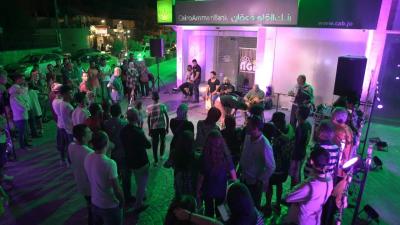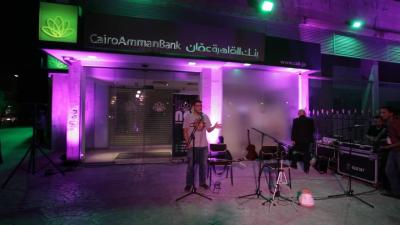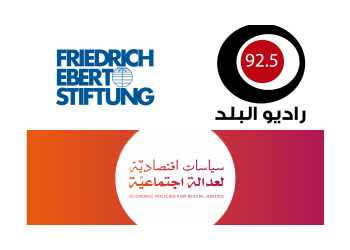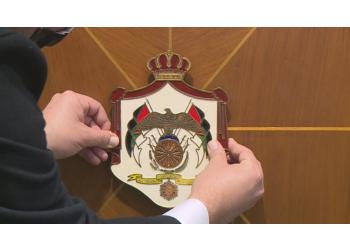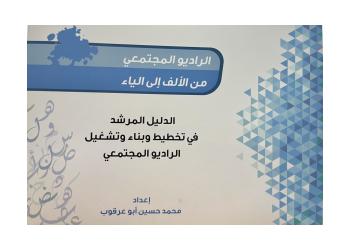
Jabal Luweibdeh, one of the seven hills of Amman, has become a battleground between artistic and business interests. Artists from this picturesque neighborhood are fighting to save the area from being overtaken by shisha cafes, restaurants, shops and the heavy traffic they cause.
Located at the center of the Jordanian capital, the area was once a lively part of the otherwise somber city, with its squares and streets lined with jasmine trees, cultural centers and stone houses with small courtyards. But particularly in the last decade, the scent of jasmine has been replaced by smoke from the mushrooming cafes and exhaust from the heavy traffic, complain residents.
“We want to smell the jasmine again instead of breathing the smoke from the vehicles and shisha cafes that have taken over the whole area,” Rashid Malhas, the director of the Friends of Al-Weibdeh Cultural Association, told Al-Monitor. This summer the association, which has been active for more than a decade, began an effort to make the mountain a cultural venue again.
As part of the project, a group of Jordanian artists performed street concerts on a corner near the neighborhood's Paris Square on Aug. 27. The musicians sang Jordanian and other Arab songs accompanied by an accordion, guitar and a Middle Eastern stringed instrument called an oud. Passers-by sang along or joined them with their own instruments.
Malhas said that they will continue the street concerts every Tuesday. “We want to show that art and culture spreads joy, and restaurants and commercial shops just suffocate the area and erase the cultural memory,” he told Al-Monitor.
Established in 2005, the Friends of Al-Weibdeh Cultural Association brings together Jordanian artists from various disciplines to lobby for the conservation of the area’s architecture and encourage cultural events. But despite its efforts and the support of international artists, the old stone houses have little chance against the the modern buildings that have appeared throughout the capital.
Hayat al-Nasser, the association's former director, has lived in Jabal Luweibdeh since the 1960s. Much has changed since then, particularly in the last 10 years, she told Al-Monitor.
“Jabal Luweibdeh has a certain charm and a serenity that grips you once you settle there. But the tall buildings erected in the last few years spoil this charm and block the view. Noise and smoke from cars and shishas in restaurants fill the air,” she lamented.
Mohammad Fadilat, a journalist for Alhurra, said that the neighborhood became a victim of its own popularity. Fadilat lived in Jabal Luweibdeh for years and believes that the beautiful and authentic neighborhood has been exploited for profit. “It is no longer treated as one of the few neighborhoods that should be saved because it conserves the social and architectural character of Amman,” he said. “Cafes and restaurants have flourished because the place was attractive for many people who visited the area, particularly researchers and intellectuals who want to visit or live here."
He added, "But the restaurants did not seek to conserve the identity of the place; they distorted it. They became a nuisance to the neighborhood. Many of the old residents have left the area to escape the noise, chaos and increasing presence of shops and new people.”
The Greater Amman Municipality announced in January that it will undertake studies on rehabilitating Jabal Luweibdeh so its architectural heritage and cultural atmosphere can be maintained.
Shima al-Tal, director of the cultural department at the Greater Amman Municipality and a resident of Jabal Luweibdeh, said it still houses several cultural centers like the Syndicate of Artists, the Authors Union, the Arts Hall, galleries and theaters.
“Six years ago, our hill of culture was transformed into an annoying commercial neighborhood. Traffic increased, new buildings that do not confirm to the traditional architecture emerged. We tried to stop some, such as a new building just opposite the authentic Bisharat Church, but we failed. We constantly try to hold cultural and artistic events in Paris Square, so that people see the beauty of the hill,” she told Al-Monitor.
Many politicians, intellectuals and artists have chosen to reside in Luweibdeh since the mid-20th century. One of the most famous is Prime Minister Omar Razzaz, who has not moved to an official residence, insisting on living in the family house owned by his father Munif Razzaz.
Though the prime minister has not left the neighborhood, many of his old neighbors may if the national and local authorities do not take action.


